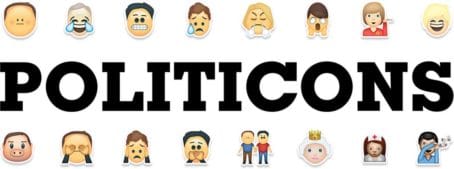Politics are about emotion, especially at the Midterm Elections in the U.S. that were widely seen as a referendum about the most controversial president in recent history.
Politics were also about emoticons on this Election Day. On the website of the New York Times, a ballot was shown throughout the day. You could click on it if you had voted, and express the feelings you experienced while in the booth: happy, angry, or worried. I had the card opened during the day and saw smiling, frowning or anxious faces constantly appearing.
Especially on the coasts the emotions danced across the screen, and it looked like the worried emoticons had the upper hand. It seemed to me a reflection of the nail biting of democratic voters in the cities in California and New York and other liberal strongholds. In their own states the ‘blue wave’ that was said to wash over the US was coming for sure. The question was what would happen in those races for the Senate, the House of Representatives and the Governor positions that symbolized the attempt of the Democrats to win back the country from Trump. In particular Beto O’Rourke’s attempt to defeat Ted Cruz in Republican stronghold Texas and Andrew Gillum’s candidacy, who had a chance to become the first Democratic governor in Florida in decades.

My study in Washington DC became a kind of ‘election cockpit’. MSNBC on my iPad, CNN on my computer, phone on twitter to track results. Sheets of paper to write down quick impressions and statistics.
A few examples: health care is a more important issue for voters than the economy, and that is what should help the Democrats. A quarter of the electorate thinks the violence that overshadowed these elections – mail bombs delivered to prominent Democrats, deadly attacks on a Pittsburgh synagogue and a yoga studio in Tallahassee – a determining factor in their vote, CNN reported. A question for later research: how exactly do voters think to bridge the extreme polarization with the choices they made these midterms?
The stakes were clear: The Democrats had instructed themselves to conquer the House of Representatives. That meant winning 23 seats from the Republicans. A feasible mission, with a lot of new candidates and a record number of women and minorities, who were able to harvest the unhappiness about Trump in states like Ohio, Pennsylvania and Virginia.
For Republicans the Senate was the most important. From a favorable situation, the GOP had to retain its majority. Of the 35 seats that were contested, nine were in the hands of the Republicans, which – in short – gave little opportunity to the Democrats to steal something from the Republican Senate majority.
During the evening the predicted scenario gradually played out. The blue wave washed over the House of Representatives where the number needed of seats to win a majority was getting smaller and smaller. The ‘Red Wall’ in the Senate remained intact, and seems to have become even a little higher.
The two chambers in Congress reflected how the country is heading in two different directions. The Democratic posters boys did not make it. Around 10:00pm the press dared to declare that Beto O ‘Rourke was short of a couple of hundred thousands votes to stop Cruz. While writing this, Gillum versus in DeSantis Florida is still ‘to close to call’ but it seems that DeSantis, a Trump epigone with the support of the president, will draw the longest straw.
 The sports bar I went to to follow the results, empties out as the success of the two big Democratic promises seems unlikely. D.C. voters are in a peculiar situation; they may vote on Senators and Representatives, who do not have the right to vote in Congress. And so the political emotion was projected onto other states. But without the symbolic victory of Democrats, the blue wave feels somehow likean expected victory, without the intoxication of winning against the odds.
The sports bar I went to to follow the results, empties out as the success of the two big Democratic promises seems unlikely. D.C. voters are in a peculiar situation; they may vote on Senators and Representatives, who do not have the right to vote in Congress. And so the political emotion was projected onto other states. But without the symbolic victory of Democrats, the blue wave feels somehow likean expected victory, without the intoxication of winning against the odds.
As soon as it becomes clear that the Democrats are going to win a majority in the House of Representatives, the conversation immediately switches to Trump. The President’s free reign made possible by the Republican majority in Congress is gone. With the House in Democratic hands, the Democrats can do what was impossible until now: force Trump to answer the many questions surrounding his presidency: about his tax return, about his business interests and ties between the Trump team and the Russians.
It is just before midnight when Nancy Pelosi appears in front of the cameras. She is the one Democrats project their partial victory upon. As the new leader of the House of Representatives, she will be the one to call Trump to account. These elections offered the Democrats momentum to rally the troops and for the Republicans to strengthen their line of defense. Both succeeded. The real battle for democracy in the U.S. starts now.
Casper Thomas is correspondent in Washington D.C. for Het Financieele Dagblad and editor of De Groene Amsterdammer.

